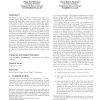Free Online Productivity Tools
i2Speak
i2Symbol
i2OCR
iTex2Img
iWeb2Print
iWeb2Shot
i2Type
iPdf2Split
iPdf2Merge
i2Bopomofo
i2Arabic
i2Style
i2Image
i2PDF
iLatex2Rtf
Sci2ools
ATAL
2007
Springer
2007
Springer
A near-optimal strategy for a heads-up no-limit Texas Hold'em poker tournament
We analyze a heads-up no-limit Texas Hold’em poker tournament with a fixed small blind of 300 chips, a fixed big blind of 600 chips and a total amount of 8000 chips on the table (until recently, these parameters defined the headsup endgame of sit-n-go tournaments on the popular PartyPoker.com online poker site). Due to the size of this game, a computation of an optimal (i.e. minimax) strategy for the game is completely infeasible. However, combining an algorithm due to Koller, Megiddo and von Stengel with concepts of Everett and suggestions of Sklansky, we compute an optimal jam/fold strategy, i.e. a strategy that would be optimal if any bet made by the player playing by the strategy (but not bets of his opponent) had to be his entire stack. Our computations establish that the computed strategy is nearoptimal for the unrestricted tournament (i.e., with post-flop play being allowed) in the rigorous sense that a player playing by the computed strategy will win the tournament with
| Added | 07 Jun 2010 |
| Updated | 07 Jun 2010 |
| Type | Conference |
| Year | 2007 |
| Where | ATAL |
| Authors | Peter Bro Miltersen, Troels Bjerre Sørensen |
Comments (0)

